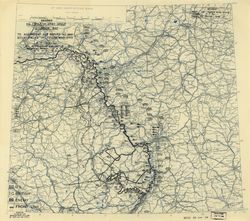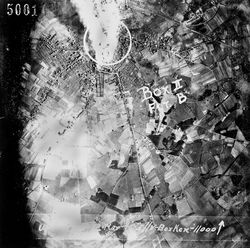 |
Lou Prucha WWII Service
|
 |
Borken, Germany
(Built Up Area)

Pilot's Flight Log |

12th Army Group Situation Map 22-Mar-1945 |
in Box 1, Flight 1, Position 5.
Click to display the official 416th Bomb Group Mission Folder, Mission Report and Operational Report
scanned to PDF files by the Air Force Historical Research Agency (AFHRA).
Photo from the collection of Phil Stanley, see Wayne Sayles' 416th Bomb Group missions #248 page.
Group, Unit and Historical Extracts for Mission 248
"416th Bombardment Group (L) - Group History 1945"
Transcribed from USAF Archives
Going back after the same town in the afternoon, smoke from the morning's bombing almost completely obscured the target. Unable to see the target on the first run, the formation dropped on Gee equipment on the second run. There was no flak. One gunner reported a single engine fighter plane approaching the formation form below at seven o'clock. Making a pass from one o'clock and firing tracers, it closed in to 800 yards. The gunner did not return his fire and made no claims. The P-47 escort steered the fighter away. Major Shaefer, Lts. Hand and Reeves, B&N, and Captain Stanley, F/O Blount and Lt. M.P. Schlefer, B&N, were the box leaders. Brigadier General Backus, commanding the 97th Combat Wing, rode as an observer with Major Shaefer.
"Attack Bombers, We Need You! A History of the 416th Bomb Group"
Ralph Conte
Pages 238 - 239
Mission #248 - 22 March - PM - Berken Communication Center. Again. Major Shaefer, Lts. Hand and Reeves, BNs with Captain Stanley and F/O Blount and Lt. Schlefer, BNs led Boxes. Brigadier General Backus Commander of the 9th Bomber Wing, rode with Captain Shaefer as an observer. Flights were led by Lts. Buskirk and Hanna BN, - Captain Tutt with Lt. Orr BN. the target was still smoking from the morning raids making aiming difficult, so GEE equipment was used to drop the loads of incendiaries on the second run. An enemy fighter made a pass at the formation, firing tracers, with no results. No return fire was made from our gunners. Our P-47 escort turned the enemy away. No flak was received on this mission.
The Ninth Bomb Division handed out a release regarding recent bombing missions we ran. The release said:
Communications inside seventeen German towns north of the Ruhr had been battered out of usefullness and smoke still covered entire town areas late Thursday, after some 1400 separate attacks by Ninth Bombardment Divison Marauders, Invaders and Havocs. These attacks have been aimed at sealing off the entire road and rail system in the northern sector of the Rhine. Since the air offensive opened in mid-morning Wednesday, nearly 2700 tons of high explosives and incendiaries have been rained on main road junctions, supply depot and other military installations, in the key German towns. Located in a 50 mile arc running mid-way between Munster and the Rhine, each town is a key in the enemy's chain of communications north of the Ruhr. Object of the current program is to cut off all road and rail facilities leading east from the northern sector of the Rhine, thereby sealing off the battle area north the Ruhr Valley.
"History of 670th Bombardment Squadron (L)"
Transcription from USAF Archives
The Borken Communications Center was bombed was with superior results on the morning mission of the 22nd of March, with twelve of our crews taking part.
"671st Bomb Squadron (L) Unit History"
Gordon Russell and Jim Kerns
The all out pounding to soften up the Munster area, north of the Ruhr continued on March 22nd, 1945 with the whole Ninth Bombardment Division concentrating its blows on communications centers in this area. The 416th Group went out twice to hit the town of Berken and returned without loss, although Lt. "Fearless" Fero crash landed his ship at Venlo, near the German border, on the morning mission.
In the morning, eight flights attacked the town with fair to superior results. Major Dunn and Lt. Brewer, leading the formation, scored an excellent with hits on buildings and roads. Lt. Brown and Lt. Kerns misidentified the primary due to smoke and hit the nearby town of Sudlohn with excellent results. Counting the quarters assessed for leads, this was Major Dunnís 65th mission, but the Major does not plan to quit. Leading formations for well over a year and scoring just about the best bombing records in the Group, Major Dunn surely deserves a trip to the States, but as he puts it: "With the was still on, I might as well stick it out".
Lt. Fero had a harrowing experience on this mission. He received several hits in the left engine coming in to the target. At the same time his right engine began to leak oil. He salvoed his bombs close to the target and headed for friendly territory. He had all he could do to keep the plane in the air and finally spotted the airfield at Venlo. After dropping his bombs his bomb-bay doors would not close so he had to pump them up by hand. He racked it back and dropped the plane in on an open field just beyond the airstrip. Making a brilliant crash-landing, neither he nor his gunner, S/Sgt.Rojas, were injured.
When the formation returned to the same target in the afternoon with incendiaries, the crews found the area covered with smoke and haze, and had to bomb on Gee with undetermined results. No flak was encountered and all crews returned safely.
The tactical significance of these recent operations was given in a 9th Bomb Division release, which follows:
Communications inside seventeen German towns north of the Ruhr had been battered out of usefulness and smoke still covered the entire town areas late Thursday, after some 1400 separate attacks by Ninth Bombardment Division Marauders, Invaders and Havocs. These attacks have been aimed at sealing off the entire road and rail system in the northern sector of the Rhine.
Since the air offensive opened in mid-morning Wednesday, nearly 2700 tons of high explosives and incendiaries have been rained on main road junctions, supply depots and other military installations, in the key German towns.
Located in a 50-mile arc running mid-way between Munster and the Rhine, each town is a key in the enemyís chain of communications north of the Ruhr.
Object of the current program is to cut off all road and rail facilities leading east from the northern sector of the Rhine, thereby sealing off the battle area north of the Ruhr Valley.
"USAAF Chronology of WWII, month by month"
TACTICAL OPERATIONS (Ninth Air Force): In Germany, nearly 800 A-20s, A-26s, and B-26s bomb 9 communications centers and a marshalling yard E of the Rhine River (plus 7 towns, flak positions, and a target of opportunity) as part of the interdiction program to impede the movement of supplies and troops; fighters escort the bombers, attack railroads and other assigned targets, fly patrols and armed reconnaissance, support the US 1st and 9th Infantry Divisions SE of Honnef and along the Wied River, cooperate with the XII Corps as it begins crossing the Rhine River in the Mainz-Oppenheim areas and with the XX Corps which begins an attack on Ludwigshafen. HQ 69th Tactical Reconnaissance Group and the 10th Tactical Reconnaissance Squadron arrive at Nancy, France from the US with F-6s; HQ 474th Fighter Group moves from Florennes, Belgium to Strassfeld, Germany; the 31st Tactical Reconnaissance Squadron, Ninth AF [attached to 9th Tactical Reconnaissance Group (Provisional)], arrives at Maastricht, the Netherlands from the US with F-6s; the 72d Liaison Squadron, Ninth Air Force (attached to Sixth Army Group), moves from Buhl to Sarreguemines, France with L-5s.
